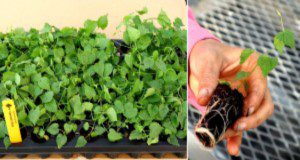The booming craft beer industry, rising prices of hops, and demand for locally-produced ingredients have recently increased interest in local hop production among growers and brewers. This article describes crop management practices and labor inputs required for small-scale hop production in Florida, with the aim of assisting growers with investment and farm management decisions. It is part of a larger series that will review the challenges of hop production in Florida, based on research experience at the UF/IFAS Gulf Coast Research and Education Center in Balm, FL. This new 6-page publication of the UF/IFAS Horticultural Sciences Department was written by Shinsuke Agehara, Mariel Gallardo, Aleyda Acosta-Rangel, Zhanao Deng, Jack Rechcigl, Tianyuan Luo, and Qi Qiu.
https://edis.ifas.ufl.edu/hs1409
Tag: Aleyda Acosta-Rangel
Construcción del Sistema de Tutorado para Lúpulo y su Establecimiento en Florida
El lúpulo (Humulus lupulus L.) es un ingrediente esencial en la elaboración de cerveza, que agrega amargura y sabor a la cerveza. Impulsada por el reciente movimiento de la cerveza artesanal, la producción de lúpulo se está expandiendo hacia estados no tradicionales en la producción de lúpulo. En Florida, aunque la producción comercial de lúpulo es casi inexistente, la cantidad de cervecerías artesanales aumentó de 45 en 2011 a 285 en 2018, y el impacto económico de la industria de la cerveza artesanal en Florida supera los $3 mil millones. Este nuevo artículo de 7 páginas, escrito por Shinsuke Agehara, Aleyda Acosta-Rangel, Zhanao Deng, Jack Rechcigl y Simon Bollin, traducido por Mariel Gallardo y publicado por el Horticultural Sciences Department de UF/IFAS, proporciona pautas y consideraciones para construir el sistema de tutorado para lúpulo y su establecimiento en Florida, utilizando como modelo, el campo de investigación del UF/IFAS Gulf Coast Research and Education Center (GCREC).
https://edis.ifas.ufl.edu/hs1408
Selection and Preparation of Planting Material for Successful Hop Production in Florida
Hops (Humulus lupulus L.), an essential ingredient in beer, have potential to develop as a viable alternative crop in Florida. In our surveys, many breweries have expressed strong interest in using locally grown hops. However, hop production is plagued by many diseases, most of which were inadvertently introduced through the movement of contaminated planting material. The primary purposes of this new 7-page article are to prevent the introduction of these diseases into the state and to provide recommendations for selecting and preparing planting material for successful hop production in Florida. This publication of the UF/IFAS Horticultural Sciences Department is part of a larger series that will review the challenges of hop production, based on research experience at the UF/IFAS Gulf Coast Research and Education Center (UF/IFAS GCREC) in Balm, FL.
https://edis.ifas.ufl.edu/hs1381
Hop Yard Establishment and Trellis Construction in Florida
Hops (Humulus lupulus L.) are an essential ingredient in brewing, adding bitterness and flavor to beer. Driven by the recent craft beer movement, hop production is expanding into nontraditional hop-producing states. In Florida, while commercial hop production is almost nonexistent, the number of craft breweries in Florida increased from 45 in 2011 to 285 in 2018, and the economic impact of Florida’s craft beer industry exceeds $3 billion. This new 7-page article, written by Shinsuke Agehara, Aleyda Acosta-Rangel, Zhanao Deng, Jack Rechcigl, and Simon Bollin and published by the UF/IFAS Horticultural Sciences Department, provides guidelines and considerations for building a hop yard in Florida, using the UF/IFAS Gulf Coast Research and Education Center’s research hop yard as a model.
https://edis.ifas.ufl.edu/hs1354


